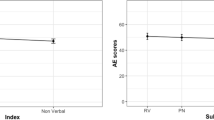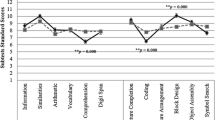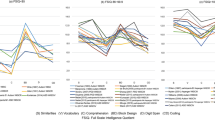Abstract
Using the Japanese version of the Wechsler Intelligence Scale for Children-Third Edition (WISC-III), 26 girls with high-functioning (IQ ≥ 70) pervasive developmental disorders (HFPDD) (mean age, 8.2 years) were compared with 116 boys with HFPDD (mean age, 9.0 years). Compared with the boys, the girls scored significantly higher on the Processing Speed index, Coding, and Symbol Search, but scored significantly lower on Block Design. Although both groups showed weakness on Comprehension in the verbal domain, the girls’ subtest profile in the performance domain was relatively even and significantly different from the boys’, which was characterized by a peak on Block Design. Such differences should be replicated, and possible behavioral, neurological, and genetic links to these sex differences should be clarified.

Similar content being viewed by others
References
American Psychiatric Association. (1994). Diagnostic and statistical manual of mental disorders (4th ed.). Washington, DC: Author.
Asarnow, R. F., Tanguay, P. E., Bott, L., & Freeman, B. J. (1987). Patterns of intellectual functioning in non-retarded autistic and schizophrenic children. Journal of Child Psychology and Psychiatry and Allied Disciplines, 28, 273–280. doi:10.1111/j.1469-7610.1987.tb00210.x.
Baron-Cohen, S., Knickmeyer, R. C., & Belmonte, M. K. (2005). Sex differences in the brain: Implications for explaining autism. Science, 310, 819–823. doi:10.1126/science.1115455.
Beebe, D. W., Pfiffner, L. J., & McBurnett, K. (2000). Evaluation of the validity of the Wechsler intelligence scale for children-third edition: Comprehension and picture arrangement subtests as measures of social intelligence. Psychological Assessment, 12, 97–101. doi:10.1037/1040-3590.12.1.97.
Bloss, C. S., & Courchesne, E. (2007). MRI neuroanatomy in young girls with autism: A preliminary study. Journal of the American Academy of Child and Adolescent Psychiatry, 46, 515–523. doi:10.1097/chi.0b013e318030e28b.
Carter, A. S., Black, D. O., Tewani, S., Connolly, C. E., Kadlec, M. B., & Tager-Flusberg, H. (2007). Sex differences in toddlers with autism spectrum disorders. Journal of Autism and Developmental Disorders, 37, 86–97. doi:10.1007/s10803-006-0331-7.
de Bruin, E. I., Verheij, F., & Ferdinand, R. F. (2006). WISC-R subtest but no overall VIQ-PIQ difference in Dutch children with PDD-NOS. Journal of Abnormal Child Psychology, 34, 254–262. doi:10.1007/s10802-005-9018-3.
Eaves, L. C., & Ho, H. H. (1996). Stability and change in cognitive and behavioral characteristics of autism through childhood. Journal of Autism and Developmental Disorders, 26, 557–569. doi:10.1007/BF02172276.
Ehlers, S., Nyden, A., Gillberg, C., Sandberg, A. D., Dahlgren, S. O., Hjelmquist, E., et al. (1997). Asperger syndrome, autism and attention disorders: A comparative study of the cognitive profiles of 120 children. Journal of Child Psychology and Psychiatry and Allied Disciplines, 38, 207–217. doi:10.1111/j.1469-7610.1997.tb01855.x.
Fombonne, E. (2003). Epidemiological surveys of autism and other pervasive developmental disorders: An update. Journal of Autism and Developmental Disorders, 33, 365–382. doi:10.1023/A:1025054610557.
Freeman, B. J., Lucas, J. C., Forness, S. R., & Ritvo, E. R. (1985). Cognitive processing of high-functioning autistic children: Comparing the K-ABC and the WISC-R. Journal of Psychoeducational Assessment, 4, 357–362. doi:10.1177/073428298500300408.
Ghaziuddin, M., & Mountain-Kimchi, K. (2004). Defining the intellectual profile of Asperger syndrome: Comparison with high-functioning autism. Journal of Autism and Developmental Disorders, 34, 279–284. doi:10.1023/B:JADD.0000029550.19098.77.
Happe, F. (1999). Autism: Cognitive deficit or cognitive style? Trends in Cognitive Sciences, 3, 216–222. doi:10.1016/S1364-6613(99)01318-2.
Holtmann, M., Bölte, S., & Poustka, F. (2007). Autism spectrum disorders: Sex differences in autistic behaviour domains and coexisting psychopathology. Developmental Medicine and Child Neurology, 49, 361–366. doi:10.1111/j.1469-8749.2007.00361.x.
Japanese WISC-III Publication Committee. (1998). Nihonban WISC-III chinou kensahou (Japanese Wechsler Intelligence Scale for Children, 3rd ed.). Tokyo: Nihon Bunka Kagakusha.
Koyama, T., Tachimori, H., Osada, H., & Kurita, H. (2006). Cognitive and symptom profiles in high-functioning pervasive developmental disorder not otherwise specified and attention-deficit/hyperactivity disorder. Journal of Autism and Developmental Disorders, 36, 373–380. doi:10.1007/s10803-006-0075-4.
Koyama, T., Tachimori, H., Osada, H., Takeda, T., & Kurita, H. (2007). Cognitive and symptom profiles in Asperger’s disorder and high-functioning autism. Psychiatry and Clinical Neurosciences, 61, 99–104. doi:10.1111/j.1440-1819.2007.01617.x.
Kurita, H., Miyake, Y., & Katsuno, K. (1989). Reliability and validity of the Childhood autism rating scale-Tokyo version (CARS-TV). Journal of Autism and Developmental Disorders, 19, 389–396. doi:10.1007/BF02212937.
Lord, C., Rutter, M., & Le Couteur, A. (1994). Autism diagnostic interview-revised: A revised version of a diagnostic interview for caregivers of individuals with possible pervasive developmental disorders. Journal of Autism and Developmental Disorders, 24, 659–685. doi:10.1007/BF02172145.
Lord, C., Schopler, E., & Revicki, D. (1982). Sex differences in autism. Journal of Autism and Developmental Disorders, 12, 317–330. doi:10.1007/BF01538320.
Manjiviona, J., & Prior, M. (1999). Neuropsychological profiles of children with Asperger syndrome and autism. Autism, 3, 327–356. doi:10.1177/1362361399003004003.
Mayes, S. D., & Calhoun, S. L. (2003). Analysis of WISC-III, Stanford-Binet:IV, and academic achievement test scores in children with autism. Journal of Autism and Developmental Disorders, 33, 329–341. doi:10.1023/A:1024462719081.
McGovern, C. W., & Sigman, M. (2005). Continuity and change from early childhood to adolescence in autism. Journal of Child Psychology and Psychiatry and Allied Disciplines, 46, 401–408. doi:10.1111/j.1469-7610.2004.00361.x.
McLennan, J. D., Lord, C., & Schopler, E. (1993). Sex differences in higher functioning people with autism. Journal of Autism and Developmental Disorders, 23, 217–227. doi:10.1007/BF01046216.
Mesibov, G. B., Schopler, E., Schaffer, B., & Michal, N. (1989). Use of the childhood autism rating scale with autistic adolescents and adults. Journal of the American Academy of Child and Adolescent Psychiatry, 28, 538–541. doi:10.1097/00004583-198907000-00012.
Moss, J., Magiati, I., Charman, T., & Howlin, P. (2008). Stability of the autism diagnostic interview-revised from pre-school to elementary school age in children with autism spectrum disorders. Journal of Autism and Developmental Disorders, 38, 1081–1091. doi:10.1007/s10803-007-0487-9.
Ozonoff, S., South, M., & Miller, J. N. (2000). DSM-IV-defined Asperger syndrome: Cognitive, behavioral and early history differentiation from high-functioning autism. Autism, 4, 29–46. doi:10.1177/1362361300041003.
Perry, A., Condillac, R. A., Freeman, N. L., Dunn-Geier, J., & Belair, J. (2005). Multi-site study of the childhood autism rating scale (CARS) in five clinical groups of young children. Journal of Autism and Developmental Disorders, 35, 625–634. doi:10.1007/s10803-005-0006-9.
Pilowsky, T., Yirmiya, N., Shulman, C., & Dover, R. (1998). The autism diagnostic interview-revised and the childhood autism rating scale: Differences between diagnostic systems and comparison between genders. Journal of Autism and Developmental Disorders, 28, 143–151. doi:10.1023/A:1026092632466.
Schopler, E., Reichler, R. J., DeVellis, R. F., & Daly, K. (1980). Toward objective classification of childhood autism: Childhood autism rating scale (CARS). Journal of Autism and Developmental Disorders, 10, 91–103. doi:10.1007/BF02408436.
Shah, A., & Frith, U. (1993). Why do autistic individuals show superior performance on the block design task? Journal of Child Psychology and Psychiatry and Allied Disciplines, 34, 1351–1364. doi:10.1111/j.1469-7610.1993.tb02095.x.
Siegel, D. J., Minshew, N. J., & Goldstein, G. (1996). Wechsler IQ profiles in diagnosis of high-functioning autism. Journal of Autism and Developmental Disorders, 26, 389–406. doi:10.1007/BF02172825.
Skuse, D. H., James, R. S., Bishop, D. V. M., Coppin, B., Dalton, P., Aamodt-Leeper, G., et al. (1997). Evidence from Turner’s syndrome of an imprinted X-linked locus affecting cognitive function. Nature, 387, 705–708. doi:10.1038/42706.
Szatmari, P., Tuff, L., Finlayson, M. A. J., & Bartolucci, G. (1990). Asperger’s syndrome and autism: Neurocognitive aspects. Journal of the American Academy of Child and Adolescent Psychiatry, 29, 130–136. doi:10.1097/00004583-199001000-00021.
Tachimori, H., Osada, H., & Kurita, H. (2003). Childhood autism rating scale-Tokyo version for screening pervasive developmental disorders. Psychiatry and Clinical Neurosciences, 57, 113–118. doi:10.1046/j.1440-1819.2003.01087.x.
Tsai, L. Y., & Beisler, J. M. (1983). The development of sex differences in infantile autism. The British Journal of Psychiatry, 142, 373–378.
Volkmar, F. R., Szatmari, P., & Sparrow, S. S. (1993). Sex differences in pervasive developmental disorders. Journal of Autism and Developmental Disorders, 23, 579–591. doi:10.1007/BF01046103.
Wechsler, D. (1991). Wechsler intelligence scale for children third edition manual. New York: The Psychological Corporation.
Wolff, S., & McGuire, R. J. (1995). Schizoid personality in girls: A follow-up study—what are the links with Asperger’s syndrome? Journal of Child Psychology and Psychiatry and Allied Disciplines, 36, 793–817. doi:10.1111/j.1469-7610.1995.tb01330.x.
World Health Organization. (1993). The ICD-10 classification of mental and behavioural disorders: Diagnostic criteria for research. Geneva: Author.
Acknowledgments
This study was supported in part by a Research Grant from the Japanese Ministry of Health, Labour and Welfare, and by the Research Institute of Science and Technology for Society, Japan Science and Technology Agency. We would like to thank Ms. Yoko Hayashi, Ms. Keiko Shimoyamada, Mr. Hiromi Ishida, Mr. Junichi Yukimoto, Ms. Tomoko Nakano, and Ms. Mika Tobari for their help with data collection.
Author information
Authors and Affiliations
Corresponding author
Rights and permissions
About this article
Cite this article
Koyama, T., Kamio, Y., Inada, N. et al. Sex Differences in WISC-III Profiles of Children with High-functioning Pervasive Developmental Disorders. J Autism Dev Disord 39, 135–141 (2009). https://doi.org/10.1007/s10803-008-0610-6
Received:
Accepted:
Published:
Issue Date:
DOI: https://doi.org/10.1007/s10803-008-0610-6




